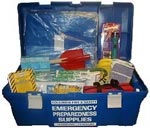 |
72-Hour Survival Kit Checklist
Please adjust this list to fit your local region and
specific family requirements |
|
| |
Item |
Notes |
 |
Drinking Water |
Three gallons of drinking water
stored for each person |
 |
Sanitation Water |
Two gallons of washing water for
each person (or have a plan for accessing water) |
 |
Food |
Three-day supply |
 |
Shelter |
Tent or preplanned location for
gathering and shelter |
 |
Wool-blend blanket or sleeping
bag |
One for each person, in
waterproof bag or container |
 |
Camp stove and fuel
|
Store fuel in safe, yet
accessible location |
 |
Cooking pots & utensils
|
Include manual can opener |
 |
Flashlights |
One for each person - LED type
preferred |
 |
AM/FM Radio with batteries |
Self powered "Freeplay" type
preferred. |
 |
Alkaline or lithium batteries |
Enough batteries to run all
flashlights and radio continuously for 3 days |
 |
Long-burning Candle
|
Preferably in "hurricane" fixture
or other safety enclosure |
 |
Mantle lantern |
With extra mantles and sufficient
fuel for three days continuous use |
 |
"Cyalume" light sticks
|
For use as markers and to comfort
small children |
 |
Windproof/waterproof matches
|
|
 |
Second method to start fire
|
Butane lighter or sparker |
 |
Disposable plates, cups and
utensils. Paper towels. |
|
 |
Ziplock bags |
Various sizes |
 |
Duct tape |
Six large rolls |
 |
Plastic sheeting |
Six large 2-mil tarps minimum.
More are better. Thicker is better. |
 |
Tools |
Include shovel, hatchet or axe,
pocket knife |
 |
First aid kit and supplies
|
With first aid manual. Include
burn gel and large dressings |
 |
Prescription medicines taken
regularly |
Consume every six months and
replace with fresh bottle |
 |
Bottle of potassium iodide
tablets |
In case of radiation exposure |
 |
Emergency battery pack for
cell phone |
Make sure phone is accessible and
operational in shelter location |
 |
50-foot nylon rope and
heavy-duty nylon tarp with grommets |
For emergency shelter
construction |
 |
Whistle with neck cord
|
|
 |
Makeshift toilet |
Can be made from a five-gallon
spackle bucket and toilet seat |
 |
Toilet paper |
|
 |
13-gallon trash can liners |
For toilet liner and other uses |
 |
Nitrile rubber gloves |
Small and large sizes. |
 |
Dust masks |
|
 |
Bottle of disinfectant |
Lysol and/or Clorox |
 |
Personal comfort kit
|
Soap, toothbrush and paste, comb,
tissue, sanitary napkins, razor, and other needed items. Sewing kit.
|
 |
Spare eyeglasses |
In case main set are broken or
unavailable |
 |
Pet food and supplies |
Include extra drinking water for
pet |
 |
Fire extinguisher |
Class ABC type |
 |
Money |
At least $500 in kit. Include
small bills, quarters for phone calls, large bills for bribes. |
 |
Important Papers
|
Copies of important documents:
wills, birth certificates, insurance forms, emergency phone numbers. |
 |
Pillows and foam sleeping pads |
Not essential but very nice to
have |
 |
Stress Relievers
|
Games, books, hard candy. For
children: small toys, paper and pen, small stuffed animal. |
 |
Extra Clothing
|
A complete outfit of appropriate
clothing for each family member. Include extra socks, underwear, hat, sturdy
shoes, and gloves |
 |
Emergency reflective blanket
|
|
 |
Durable water resistant duffel
bag, frame pack or day pack |
In case of evacuation |
